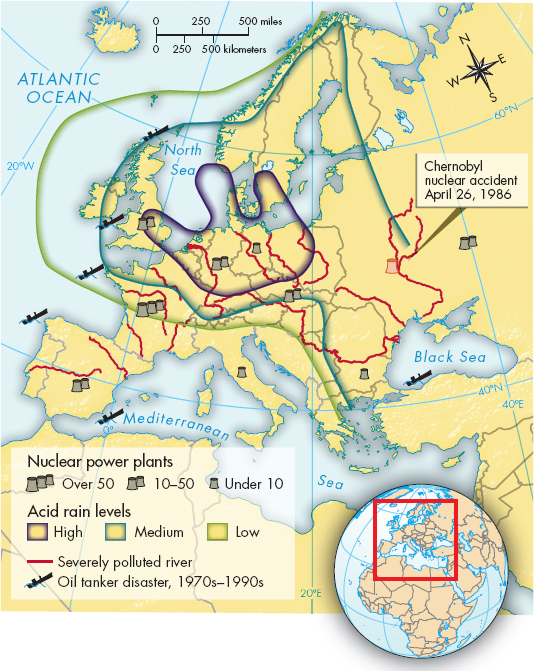The Rise of the Environmental Movement

 Pollution in Europe, ca. 1990 Despite attempts to remedy the negative consequences of the human impact on the environment, pollution remains a significant challenge for Europeans in the twenty-
Pollution in Europe, ca. 1990 Despite attempts to remedy the negative consequences of the human impact on the environment, pollution remains a significant challenge for Europeans in the twenty-By the 1970s, the destructive environmental costs of industrial development in western Europe and the East Bloc were everywhere apparent. The mighty Rhine River was an industrial sewer. The forests of southwestern Germany were dying from acid rain, a result of smokestack emissions. The coast of Brittany, in northwest France, was fouled by oil spills from massive tanker ships. Rapid industrialization in the East Bloc had been undertaken with little regard for environmental impact. Serious accidents at nuclear plants — at Three Mile Island in Pennsylvania (1979) and at Chernobyl in Soviet Ukraine (1986) — revealed nuclear power’s potential to create human and environmental disaster (Map 29.1). These were just some examples of the environmental threats that inspired a growing environmental movement to challenge government and industry to clean up their acts.
Environmentalists had two main agendas. First, they worked to lessen the ill effects of unbridled industrial development on the natural environment. Second, they argued that local environmental problems often increased human poverty, inequality, and violence around the globe. Environmental groups pursued these goals in many ways. Some used the mass media to reach potential supporters; some worked closely with politicians and public officials to change government policies. Others took a more activist stance, organizing protests and demonstrations.
Environmental protesters also built new institutions, particularly in North America and western Europe. In 1971, Canadian activists established Greenpeace, a nongovernmental organization dedicated to environmental conservation and protection. Greenpeace quickly grew into an international organization, with strong support in Europe and the United States. In West Germany, in 1979, environmentalists founded the Green Party, a political party to fight for environmental causes. The West German Greens met with astounding success when they elected members to parliament in 1983, the first time in sixty years that a new political party had been seated in Germany. (See “Picturing the Past: Green Party Representatives Enter Parliament.”) Their success was a model for like-

CONNECTIONS: What does the Green Party victory in 1983 tell you about political debate in a postindustrial society? Are there continuities with the social activism of the 1960s counterculture, or was this something new?